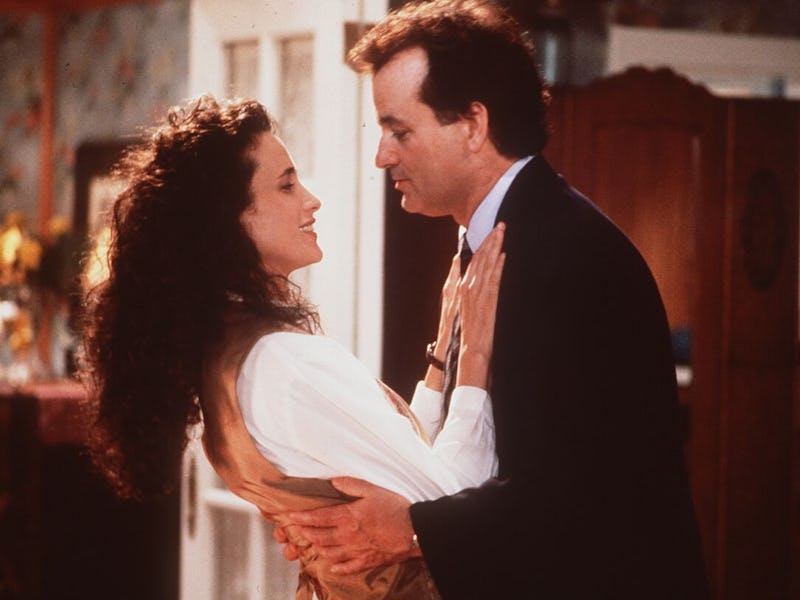How Groundhog Day Rewrote the Rules of Sci-Fi
Today, fans would demand to know why Bill Murray was trapped. 30 years ago, no one cared.

Few movies achieve the level of instant recognition offered by Groundhog Day. Since its premiere 30 years ago, it’s been regarded as the gold standard of the time loop movie. If we were to explore the movies, TV shows, and parodies it inspired, we’d be here all day.
If you somehow need a refresher, Bill Murray is cynical, disgruntled weatherman Phil Connors, who’s once again grudgingly heading out on his annual Groundhog Day assignment to report live at the ceremony in Punxsutawney. Phil openly despises what he sees as a cutesy tradition in an equally saccharine town, which puts him at odds with his charming producer, Rita (Andie McDowell). Phil, of course, soon finds himself trapped in a mysterious time loop, forcing him to relive his most hated holiday over and over again.
We all know Groundhog Day as a riotous comedy, but it was originally much darker. Screenwriter Danny Rubin wrote the opening scene with Phil already in the time loop, implying that he had been there for a long time. This might have worked for a different genre, but it doesn’t set the right tone for a comedy. Director Harold Ramis knew as much, and we can be thankful that associate producer Whitney White suggested starting the film before the time loop. Not only did this decision better establish Phil as a character, but it was important for the audience to experience the slapstick of Phil freaking out when he realizes he’s trapped.
Groundhog Day works so well because it perfectly balances out dark moments with comedy. Ramis knew that even in Phil’s most depressing moments, there was room to inject just the right amount of humor. When it’s Groundhog Day again for the third time, and Phil helplessly realizes he’s stuck with no way out, he does what most of us would do: descend into complete hedonism. With no lasting consequences to face, Phil is free to manipulate everyone and everything for his own gain. He goes joyriding, steals money, tricks women into sleeping with him, and gorges himself on junk food. Who wouldn’t indulge in a pastry binge knowing they didn’t have to fear weight gain or a massive coronary?
Rita looks on in disbelief as Phil chugs coffee straight from the pot after stuffing himself with pastries.
It’s all fun and games for a while, but once Phil develops real feelings for Rita, he recognizes how alone he is. Nothing he does matters, and he can’t build any meaningful relationships. In desperation, Phil tries to kill himself, but even that just brings him back to the start of the day. While the circumstances are depressing, we can still find the humor in his elaborate death stunts, especially in what’s probably the movie’s best scene: Phil abducting Punxsutawney Phil for a wild car chase leading to a fiery (but temporary) demise.
The movie gives no explanation as to how or why Phil gets trapped in the time loop. When the studio asked for a specific reason for Phil’s dilemma, Ramis and the writers struggled to come up with an explanation before reluctantly suggesting that Phil gets cursed by an ex-girlfriend. Everyone was relieved when this idea was nixed. While it’s natural to question it, a clear-cut explanation would have cheapened and bloated the story. The plot works better without any reasoning because it puts the audience in the same boat as Phil. We don’t know why this is happening to him, how the time loop works, or how (or if) he can escape. The audience is as clueless as he is.
Thinking the groundhog might be causing the time loop, Phil abducts Punxsutawney Phil.
Phil is only freed when he learns to be a better person, but the audience doesn’t know that helping others is the key to his freedom. Having a random character curse him to live the same day over and over until he improves himself would be lazy and boring. It would be less fun if we knew the whole time that Phil just needs to get his act together to escape, but it’s a joy to watch him flounder and make outrageous decisions before deciding of his own accord to better himself when he believes the time loop is his eternity.
Groundhog Day is dark without giving into despair while steadily maintaining its sharp wit and humor. It’s sweet without being cloying. Our hero experiences genuine growth that’s well-developed and believable. It’s a movie that could have easily succumbed to lazy rom-com or sci-fi tropes, as many of its countless imitators have. But, with clever writing and masterful directing, we were instead lucky enough to receive a timeless story that’s romantic, dark, hilarious, and utterly memorable.
This article was originally published on